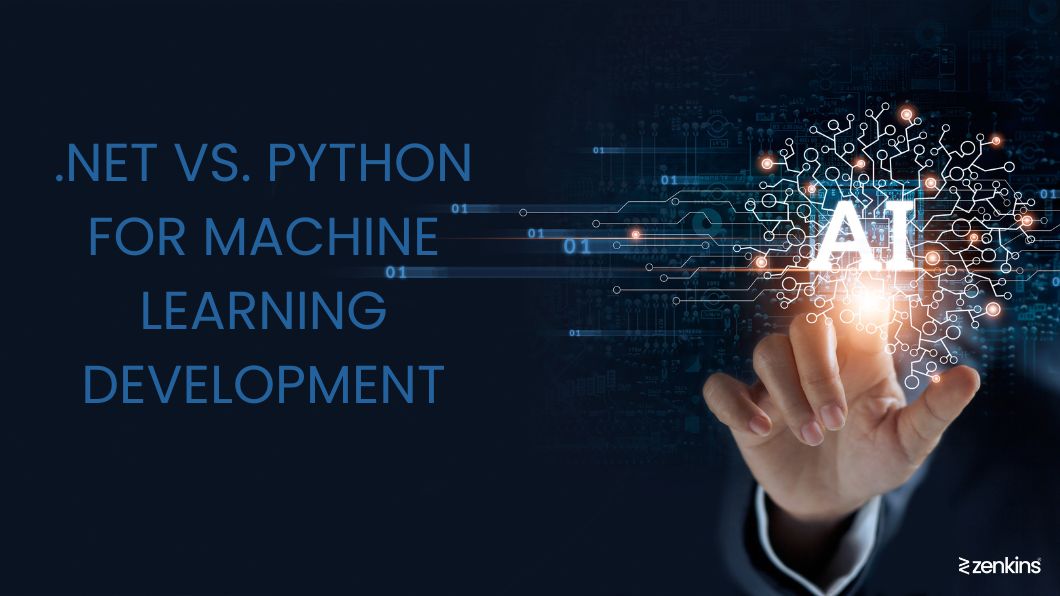AI & ML Momentum: .NET vs. Python for Machine Learning Development
Table of Contents
Introduction to AI and ML in Software Development
Defining Artificial Intelligence (AI)
Artificial Intelligence (AI) refers to the simulation of human intelligence in machines that are programmed to think and learn like humans. It involves the development of computer systems capable of performing tasks that usually require human intelligence, such as speech recognition, problem-solving, and decision-making.
Understanding Machine Learning (ML)
Machine Learning (ML) is a subset of AI that focuses on enabling computers to learn and make predictions or decisions without being explicitly programmed. It involves the development of algorithms and models that allow computers to automatically learn and improve from experience or data.
Role of AI and ML in Software Development
AI and ML have become integral parts of software development, enabling developers to create intelligent applications that can automate tasks, make predictions, and provide personalized experiences. They are used in various domains, including natural language processing, image recognition, recommendation systems, fraud detection, and many more.
Overview of .NET Framework for Machine Learning Development
Introduction to .NET Framework
The .NET Framework is a software development platform developed by Microsoft. It provides a consistent programming model, libraries, and tools for building various types of applications, including machine learning applications. .NET supports multiple programming languages, including C# and F#, and provides a robust ecosystem for building scalable and reliable applications.
Key Features of .NET for Machine Learning
.NET offers several features that make it suitable for machine learning development. It provides a rich set of libraries, such as ML.NET and Accord.NET, which offer various machine learning algorithms and data manipulation capabilities. It also supports seamless integration with other Microsoft technologies, such as Azure Machine Learning, making it easy to deploy and scale ML models.
Popular Libraries and Tools for ML in .NET
Some popular libraries and tools for machine learning in .NET include:
– ML.NET: A cross-platform open-source framework by Microsoft, designed to make machine learning accessible to .NET developers.
– Accord.NET: A popular machine learning framework that provides a wide range of algorithms, statistical analysis tools, and computer vision capabilities.
– TensorFlow.NET: A .NET binding to TensorFlow, an open-source machine learning framework created by Google, known for its deep learning capabilities.
Overview of Python for Machine Learning Development
Introduction to Python
Python is a versatile and beginner-friendly programming language that has gained immense popularity in the field of machine learning. It offers concise and readable syntax, making it easier to write and understand code. Python also has a vast ecosystem of libraries and tools specifically built for machine learning development.
Key Features of Python for Machine Learning
Python provides several features that make it a preferred choice for machine learning development. It has a large collection of libraries, such as NumPy, Pandas, and Scikit-learn, which offer powerful data manipulation, analysis, and machine learning capabilities. Python’s simplicity and high-level abstractions make it easier to prototype and experiment with different machine learning algorithms.
Popular Libraries and Tools for ML in Python
Python has an extensive collection of libraries and tools tailored for machine learning, including:
– Scikit-learn: A widely-used machine learning library that provides efficient tools for data mining, classification, regression, clustering, and more.
– TensorFlow: An open-source deep learning framework that enables developers to build and deploy deep neural networks for various machine learning tasks.
– PyTorch: Another popular deep learning framework that offers dynamic computational graphs and powerful GPU acceleration.
Comparing Features and Capabilities of .NET vs. Python for ML
Language Syntax and Flexibility
Python’s simplicity and intuitive syntax make it easy for beginners to grasp and write code quickly. On the other hand, .NET languages like C# and F# offer strong typing and compile-time safety, making them well-suited for large-scale projects and enterprise applications.
Performance and Speed
In terms of performance, .NET and Python have different trade-offs. .NET, being a compiled language, generally offers faster execution speeds. However, Python’s extensive libraries, such as NumPy and Pandas, leverage optimized C and Fortran code under the hood, providing efficient numerical computations.
Availability of ML Libraries and Packages
Both .NET and Python have a wide range of machine learning libraries and packages. Python’s ecosystem, with libraries like Scikit-learn, TensorFlow, and PyTorch, has a more established and comprehensive collection. However, .NET’s ML.NET and Accord.NET are actively developed and offer robust machine learning capabilities.
Integration with Existing Software Infrastructure
.NET seamlessly integrates with other Microsoft technologies, such as Azure Machine Learning and SQL Server, providing a cohesive ecosystem for building end-to-end ML solutions. Python, being a popular language in the data science community, offers extensive integration with various tools and frameworks, making it easy to work with different components of the ML workflow.
Performance and Scalability: .NET vs. Python for ML
Performance Benchmarks and Comparisons
When it comes to performance, .NET and Python have their own strengths and weaknesses in the realm of machine learning. .NET, being a compiled language, offers faster execution times compared to Python, which is an interpreted language. However, Python’s extensive libraries and frameworks dedicated to machine learning, such as TensorFlow and PyTorch, make it a popular choice despite its slightly slower performance. Ultimately, the performance difference between the two may not be significant enough to outweigh the benefits of using Python’s ML ecosystem.
Scalability Considerations
Scalability is an important aspect to consider when developing machine learning applications. .NET provides strong support for building scalable applications, with features like asynchronous programming and efficient multi-threading. On the other hand, Python’s Global Interpreter Lock (GIL) can limit its scalability in certain scenarios. However, Python’s ability to leverage distributed computing frameworks like Apache Spark and Dask can help overcome these limitations, making it a viable choice for scalable ML development.
Handling Large Datasets
Dealing with large datasets is a common challenge in machine learning. .NET offers efficient memory management and optimized data access, making it suitable for handling large datasets. Python, with its rich ecosystem of data manipulation and analysis libraries like Pandas, NumPy, and Dask, provides powerful tools for working with large datasets. Additionally, Python’s simplicity and ease of use make it an attractive option for data preprocessing and exploratory analysis, which are crucial steps in ML development.
Community and Ecosystem Support for .NET and Python in ML
Community Engagement and Developer Adoption
The community behind a programming language can greatly influence its growth and innovation. Python has an incredibly vibrant and active community dedicated to machine learning and artificial intelligence. The availability of forums, online communities, and open-source projects fosters collaboration and knowledge sharing. While the .NET community is also growing, Python’s ML community offers a wealth of support and expertise that is hard to match.
Availability of Learning Resources and Documentation
Learning resources and documentation play a crucial role in the adoption and success of a technology. Python’s ML ecosystem benefits from an abundance of high-quality tutorials, documentation, and online courses. The availability of resources like books, video tutorials, and MOOCs (Massive Open Online Courses) allows developers to quickly grasp ML concepts and start building models. While .NET also has learning resources available, Python’s ML community surpasses it in terms of quantity and accessibility.
Support and Updates from the Development Community
Regular updates, bug fixes, and new features are essential for any technology to stay relevant in a rapidly evolving field like ML. Both .NET and Python have active development communities that continually enhance their respective ML tools and frameworks. However, Python’s ML ecosystem benefits from a larger community, resulting in faster updates, a wider range of libraries, and better support for cutting-edge techniques. This community-driven development approach ensures that Python remains at the forefront of ML innovation.
Choosing the Right Technology: Factors to Consider
Project Requirements and Constraints
Before making a decision, it’s crucial to consider the specific requirements and constraints of your ML project. Evaluate factors such as performance, scalability, dataset size, and integration with existing systems. If your project demands high performance and tight integration with other .NET technologies, leveraging .NET for ML development may be a suitable choice. Conversely, if you require extensive ML libraries and tools, and prioritize ease of use and flexibility, Python should be considered.
Development Team Expertise and Familiarity
The expertise and familiarity of your development team with a particular programming language can greatly impact productivity and the quality of the end product. If your team has extensive experience with .NET and limited exposure to Python, sticking with .NET may expedite the development process. However, if your team is well-versed in Python and has experience with its ML libraries, using Python would allow them to leverage their existing skills effectively.
Long-term Maintenance and Support
Consider the long-term maintenance and support requirements of your ML application. .NET benefits from strong enterprise support and a mature ecosystem, making it a reliable choice for organizations with long-term maintenance needs. Python’s expansive third-party libraries and active community support also ensure ample support options. Ultimately, choose the technology that aligns with your organization’s long-term goals and support capabilities.
Evaluation of Cost and Licensing
Cost considerations are crucial when choosing a technology for ML development. Both .NET and Python are open-source and free to use. However, if you require enterprise-level support and additional tools, licenses and associated costs for some libraries or frameworks may apply. Evaluate your budget and consider the potential costs involved when selecting the appropriate ML technology for your project.
Conclusion: Making an Informed Decision for ML Development
Choosing the right technology for machine learning development is a critical decision that should be based on a careful evaluation of various factors. While .NET offers performance advantages and scalability, Python’s extensive ecosystem, community support, and ease of use make it a compelling choice. Consider your project requirements, development team expertise, long-term maintenance needs, and financial considerations to make an informed decision. Remember, both .NET and Python have their unique strengths, and ultimately, selecting the appropriate technology depends on your specific ML project.
In conclusion, both .NET and Python provide strong options for machine learning development. The choice between the two depends on factors like developer familiarity, project requirements, performance needs, and integration capabilities. Whether you prefer the power and flexibility of Python or the enterprise-grade ecosystem of .NET, there are ample resources and libraries available to support your machine learning journey.
By considering these factors and evaluating the unique needs of the project, developers can make an informed decision on whether to leverage the power of .NET or Python for their machine learning endeavors.
FAQ
Can I use both .NET and Python for machine learning development?
Yes, you can use both .NET and Python for machine learning development. While .NET provides a strong framework and libraries for machine learning, Python has a vast ecosystem of libraries and tools specifically designed for data science and machine learning. It is common for developers to use .NET for the overall application development and leverage Python for the ML-specific tasks.
Which technology is better for performance-critical machine learning applications?
If performance is a critical factor for your machine learning application, .NET can be a better choice. .NET is known for its performance, especially when it comes to handling large datasets and complex computations. However, the performance of Python can be significantly improved by leveraging specialized libraries like NumPy, SciPy, and TensorFlow.
Is Python more popular than .NET for machine learning?
Python is currently more popular than .NET for machine learning development. Python’s popularity in the data science community, its extensive collection of libraries like TensorFlow, PyTorch, and scikit-learn, and its ease of use have made it the preferred choice for many machine learning practitioners. However, .NET is gaining momentum in the ML landscape with the introduction of ML.NET and its integration with popular ML frameworks.
Can I deploy machine learning models developed in .NET or Python interchangeably?
Yes, you can deploy machine learning models developed in both .NET and Python interchangeably. Both technologies offer ways to export trained models in common formats such as ONNX or PMML, which can be used for deployment in various environments. Additionally, both .NET and Python provide options to deploy models as RESTful APIs, making it easier to integrate them into different applications and systems.




